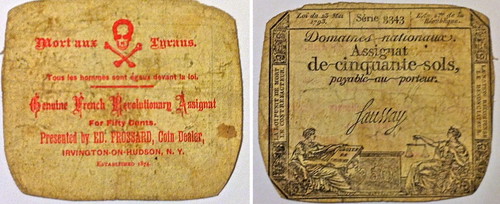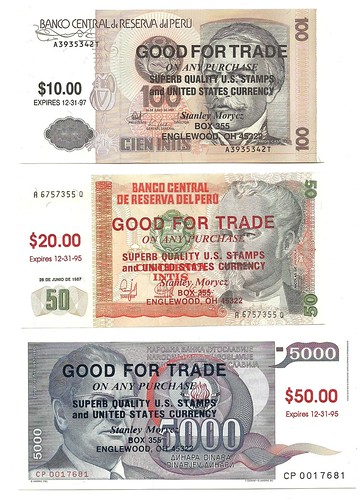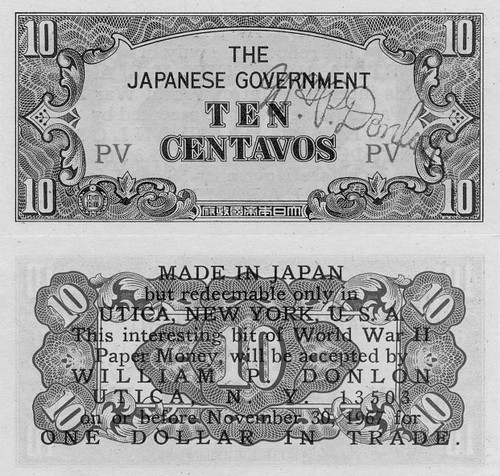
PREV ARTICLE
NEXT ARTICLE
FULL ISSUE
PREV FULL ISSUE
MORE BANKNOTES AS BUSINESS CARDSDavid Fanning writes: On "Banknotes as Business Cards," here is one of the coolest pieces of ephemera in my personal collection: a French Revolutionary assignat for 50 sols whose blank reverse has been printed as a business card for New York dealer Ed Frossard. With its skull and crossbones device and revolutionary legends, it is an unusually striking example of a banknote reformatted for use as a business card. It's the only one of these I've seen. I purchased it in a 2008 Smythe sale.

Very neat item! I hadn't seen this before.
-Editor
Pete Smith writes: Attached is a scan of banknotes overprinted by Stanley Morycz. You might call these a business card but they are also "good for" trade tokens.

Peter Huntoon writes: Here is a nice example from Bill Donlon.

Peter's description of the note is below. Thanks!
-Editor
The name William P. Donlon in the 1960s and 1970s was synonymous with the sale of high grade, mostly large size type notes. His catalogs "United States Large Size Paper Money" and "United States Small Size Paper Money" coupled with his several auction catalogs are now part of our classic literature. Donlon was an 'old timer' who was one of the few people actually present at all seven of the famous Albert A. Grinnell sales held from 1944 to 1946. He purchased and subsequently held many of the spectacular notes in that sale. The depth of his holdings was revealed when he offered the major part of his remaining collection for auction in 1971. That sale was particularly rich in National Bank Notes and large size Federal type notes. Mr. Donlon was a collector turned dealer. His primary occupation was that of owner of an amusement park in Utica. His dealing career began in 1958 upon his retirement from his business. George Warner, a dealer from Sheridan Wyoming, who specializes in MPC, fractional currency and small size type notes, obtained the interesting advertising piece produced by Donlon shown here. It was included as part of an MPC collection that George purchased in 2004. On the face is a red rubber stamped facsimile of Donlon's signature. On the back, overprinted in black ink in nine lines, is MADE IN JAPAN but redeemable only in UTICA, NEW YORK, U. S. A. This interesting bit of World War II Paper Money will be accepted by WILLIAM P. DONLON, UTICA, N. Y 13503 on or before November 30, 1967 for ONE DOLLAR IN TRADE. Peter adds: See the section below for the interesting story behind these advertising handbills. Another twist on an old idea. With respect to the use of old currency as business cards and handbills, perhaps Ecclesiastes said it the best: "The thing that hath been, it is that which shall be; and that which is done is that which shall be done; and there is no new thing under the sun." Or paraphrasing Harry Truman: The only thing you don't know about human endeavor is what you haven't read in a history book.

One of the most supremely beautiful series of bank notes ever created were the revolutionary issues for El Banco del Estado de Chihuahua. The bank never existed other than in concept, and the notes never circulated as legitimate money as far as I can determine. They were apparently designed as currency to be issued by Pancho Villa's government while he was the self-appointed governor of Chihuahua following his consolidation of power there during the revolution. Many were used as movie money in 1940 vintage films - maybe even 1930 films - however I don't recall seeing many movies that employed El Banco notes. Far more commonly used were the El Estado de Chihuahua notes. Nevertheless, El Banco notes were apparently used widely, but the series had the disadvantage of having no 1000 peso. Some studio had crude 1000s printed for it which, if my memory serves me well, was accomplished by adding zeros to the 10 peso note. The faces of the spurious 1000s that I have seen are unattractive being offset printed in blue ink. You occasionally can find them for sale. The other place the notes turned up was in border towns where American tourists were handed specimens by hawkers as they crossed the border. These contained advertisements overprinted on the backs. These handbills are particularly interesting, and highly collectable by specialists. At least they were used in commerce! They seem to have been utilized in several border towns, always, to my knowledge, with advertising for south of the border businesses. I believe they were used particularly heavily in Juarez and Tijuana. Naturally the survivors are somewhat dog eared because they were used.
I understand from dealers that only the low denominations were used as handbills. I have observed 5s and 10s but my exposure to them is very limited so my observations should be considered incomplete. A nice example is illustrated here. It exhibits a rather sloppy cut revealing that it was probably trimmed from the sheet using a hand operated paper shear after the advertisement was overprinted.
Paul Bosco submitted the following thoughts on a related topic. Thanks!
-Editor
I have seen this phenomenon, but not being a "ragpicker" I have not paid much attention. Some notes are one-sided, and thus convenient for overprinting on the blank side. The Williams overprint blends in with the rest of the note's design. Possibly more interesting are propaganda notes, which look like banknotes at a glance, inducing people to pick them up off the ground. Nazi notes attacking "the Jew Morgenthau" (Roosevelt's Treasury Secretary) come to mind. Many a New Yorker has stooped to pick up a $20 bill, only to be apprised by non-standard inscriptions that one should not store up his treasures on Earth. Politicians have used paper money imitations as handbills. That erstwhile politico John Wilson issued a very attractive $3 bill for an ANA election. (He won.) Paper money is a perfect size for a handbill, but not a business card. In the late 1800s, paper trade cards -about the size of postcardsâ€"were very popular, but their use subsided, possibly because so many were produced in Nuremburg (Germany), and then came World War One. Advertising notes are not uncommon. My Favorite is the Hair-Oil notes -hundreds of them-- that Mae West, peeking quickly into W.C. Fields' suitcase, takes for real in "My Little Chickadee", inducing her to marry him for his "money". I myself employ a variation on this theme. I print my business card on adhesive paper and stick It on New York City bus-&-subway "MetroCards". They are plastic, so you can't write on them, but out-of-towners think they are a cool NYC collectible. New Yorkers commend me on "going green". People have called me a genius, but I think, if only this one time, their standards are too low. This is approximately the 163,765th consecutive business idea of mine which no one else has copied.
To read the earlier E-Sylum article, see:
BANKNOTES AS BUSINESS CARDS
(//www.coinbooks.org/esylum_v14n44a23.html)
The Numismatic Bibliomania Society is a non-profit organization promoting numismatic literature. See our web site at coinbooks.org. To submit items for publication in The E-Sylum, write to the Editor at this address: whomren@gmail.com To subscribe go to: https://my.binhost.com/lists/listinfo/esylum All Rights Reserved. NBS Home Page Contact the NBS webmaster 
|